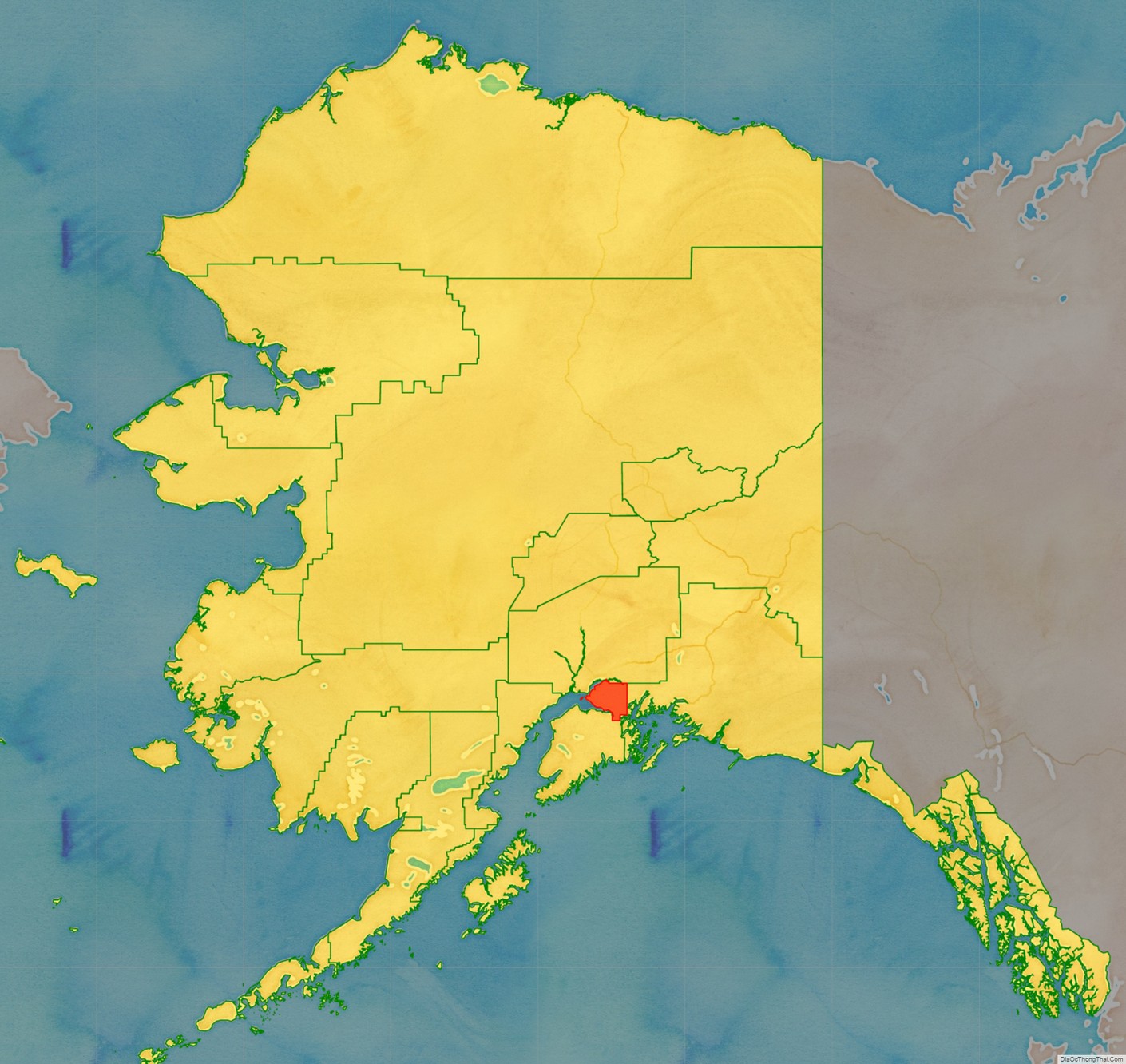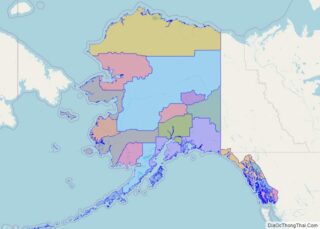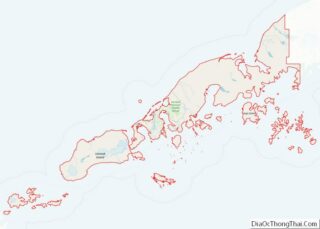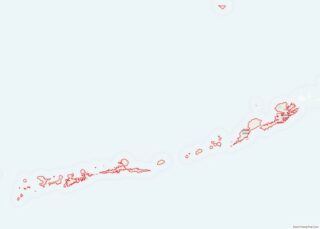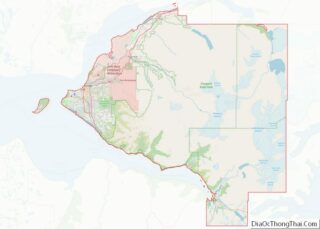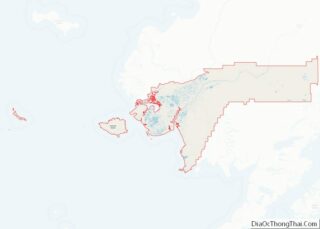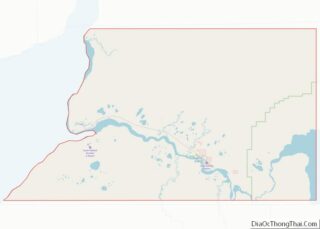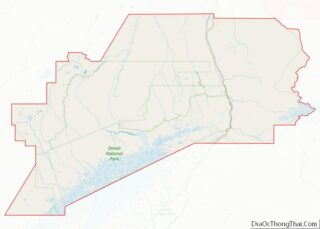Anchorage (Tanaina: Dgheyay Kaq’; Dgheyaytnu) is the largest city in the U.S. state of Alaska by population. With a population of 291,247 at the 2020 census, it contains nearly 40% of the state’s population. The Anchorage metropolitan area, which includes Anchorage and the neighboring Matanuska-Susitna Borough, had a population of 398,328 in 2020, accounting for more than half the state’s population. At 1,706 sq mi (4,420 km) of land area, the city is the fourth-largest by area in the United States and larger than the smallest state, Rhode Island, which has 1,212 sq mi (3,140 km).
Anchorage is in Southcentral Alaska, at the terminus of the Cook Inlet, on a peninsula formed by the Knik Arm to the north and the Turnagain Arm to the south. In September 1975, the City of Anchorage merged with the Greater Anchorage Area Borough, creating the Municipality of Anchorage. The municipal city limits span 1,961.1 sq mi (5,079.2 km), encompassing the urban core, a joint military base, several outlying communities, and almost all of Chugach State Park. Because of this, less than 10% of the Municipality (or Muni) is populated, with the highest concentration of people in the 100 square-mile area that makes up the city proper, on a promontory at the headwaters of the inlet, commonly called Anchorage, the City of Anchorage, or the Anchorage Bowl.
Due to its location, almost equidistant from New York City, Tokyo, and Frankfurt, Germany (across the Arctic Ocean), Anchorage lies within 10 hours by air of nearly 90% of the industrialized world. For this reason, Ted Stevens Anchorage International Airport is a common refueling stop for international cargo flights and home to a major FedEx hub, which the company calls a “critical part” of its global network of services.
Anchorage has won the All-America City Award four times: in 1956, 1965, 1984–85, and 2002, from the National Civic League. Kiplinger has named it the United States’ most tax-friendly city.
| Name: | Anchorage Municipality |
|---|---|
| FIPS code: | 02-020 |
| State: | Alaska |
| Named for: | The anchorage at the mouth of Ship Creek |
| Land Area: | 1,706.89 sq mi (4,420.81 km²) |
| Population Density: | 170.6/sq mi (65.88/km²) |
Anchorage Municipality location map. Where is Anchorage Municipality?
History
Archaeological evidence discovered at Beluga Point just south of Anchorage proper, along the Turnagain Arm, suggests that habitation of the Cook Inlet began 5,000 years ago by a tribe of Alutiiq Eskimos that arrived by kayak. As this population moved on, they were followed by a second wave of Alutiiq occupation beginning roughly 4,000 years ago, followed by a third wave around 2,000 years ago. Around 500 AD the Chugach Alutiiq were displaced by the arrival of Dena’ina Athabaskans, who entered through the mountain passes. The Dena’ina had no fixed settlements, migrating throughout the area with the seasonal changes, fishing along coastal streams and rivers in the summer, hunting moose, mountain goats, and Dall sheep in early fall, and picking berries in late fall. They tended to winter near trading junctions along common travel routes, where they traded with other Dena’ina and Ahtna tribes from nearby areas.
Captain James Cook was among the first European explorers to map the Alaskan coastline, and many of the geographical features (mountains, islands, rivers, waterways, etc.) still bear the names he gave them. Cook was searching for the fabled Northwest Passage, a route that would provide a shorter means of reaching the Pacific from Europe than sailing east around Asia or south around South America. On May 15, 1778, after enduring weeks of hard weather, Cook turned into an inlet between two landmarks he called Cape Douglas and Mount St. Augustine. He anchored his ship, HMS Resolution, at a place he called “Anchor Point” (later named “Anchorage” as another Anchor Point existed to the south near Homer, Alaska), near a creek he dubbed “Ship Creek” nestled between two large arms (waterways). Cook spent ten days exploring the inlet named after him. He first sent William Bligh to scout the north arm, where he met with the Dena’ina Natives of the Eklutna area, who told him the name of the Knik Arm and that it was not the Northwest Passage, but rather an outlet for two rivers (the Knik and Matanuska Rivers). Cook then sailed south to scout the other arm, and in a bad mood after running the Resolution aground on a sandbar on his way back out of the shallow waters, called it “River Turnagain”, having found no sign of the passage there either.
In the 19th century, Russian presence in south-central Alaska was well-established. The Russians placed trading posts along Cook Inlet, such as the Shelikhov-Golikov Company’s post at Niteh on the Palmer Flats (between the Knik and Matanuska Rivers), which in turn created small agricultural communities in Ninilchik, Seldovia, and Eklutna. The Russians also introduced diseases such as smallpox that had devastating effects on the local Native population, which plummeted by half just 10 years after the first census.
In 1867, U.S. Secretary of State William H. Seward brokered a deal to purchase Alaska from Imperial Russia for $7.2 million, or about two cents an acre ($117.2 million in 2021 dollars). His political rivals lampooned the deal as “Seward’s folly”, “Seward’s icebox” and “Walrussia”. In 1888, gold was discovered along Turnagain Arm just south of modern-day Anchorage, leading to a new influx of prospectors, and small towns such as Spenard, Hope, Rainbow, Bird, Indian, and Girdwood began to spring up.
Alaska became an organized incorporated United States territory in 1912. Anchorage, unlike every other large town in Alaska south of the Brooks Range, was neither a fishing nor mining camp. The area surrounding Anchorage lacks significant economic metal minerals. A number of Dena’ina settlements existed along Knik Arm for years. By 1911 the families of J. D. “Bud” Whitney and Jim St. Clair lived at the mouth of Ship Creek and were joined there by a young forest ranger, Jack Brown, and his bride, Nellie, in 1912.
The city grew from its happenstance choice as a site for railroad construction to begin in 1914. The waters near Ship Creek were deep enough for barges and small ships to dock, and under the direction of Frederick Mears, it became a railroad-construction port for the Alaska Engineering Commission. The area near the mouth of Ship Creek, where the railroad headquarters was, quickly became a tent city. Anchorage formed at a time when proponents of Prohibition were gaining traction, and as part of an effort to stem the flow of the alcohol trade, at the direction of President Woodrow Wilson and with the symmetry of the US Army, a town site was mapped out on higher ground to the south of the tent city, with the condition that a person’s land could be repossessed if caught breaking the alcohol laws. Anchorage has been noted in the years since for its order and rigidity compared with other Alaska town sites. In 1915, territorial governor John Franklin Alexander Strong encouraged residents to change the city’s name to one that had “more significance and local associations”. In the summer of that year, residents held a vote to change the city’s name; a plurality favored the name “Alaska City”, but the territorial government ultimately declined to change the city’s name. Anchorage was incorporated on November 23, 1920.
Construction of the Alaska Railroad continued until its completion in 1923. The city’s economy in the 1920s and 1930s centered on the railroad. Colonel Otto F. Ohlson, the Swedish-born general manager of the railroad for nearly two decades, became a symbol of residents’ contempt due to the firm control he maintained over the railroad’s affairs, which by extension became control over economic and other aspects of life in Alaska.
Between the 1930s and the 1950s, the city experienced massive growth as air transportation and the military became increasingly important. Aviation operations in Anchorage commenced along the firebreak south of town (today’s Delaney Park Strip), which residents also used as a golf course. An increase in air traffic led to clearing of a site directly east of town site boundaries starting in 1929; this became Merrill Field, which served as Anchorage’s primary airport during the 1930s and 1940s, until Anchorage International Airport superseded it in 1951. Merrill Field still sees a significant amount of general aviation traffic.
Elmendorf Air Force Base and the United States Army’s Fort Richardson were constructed in the 1940s, and served as the city’s primary economic engine until the 1968 Prudhoe Bay discovery shifted the thrust of the economy toward the oil industry. The 2005 Base Realignment and Closure process led to the combining of the two bases (along with Kulis Air National Guard Base) to form Joint Base Elmendorf-Richardson.
The Good Friday earthquake of March 27, 1964, hit Anchorage hard at a magnitude of 9.2, killing 115 people and causing $116 million in damages ($750 million in 2021 dollars). The earth-shaking event lasted nearly five minutes; most structures that failed remained intact for the first few minutes then failed with repeated flexing. It was the world’s fourth-largest earthquake in recorded history. Broadcaster Genie Chance has been credited with holding Anchorage together, as she immediately rushed to the Anchorage Public Safety Building and stayed on the KENI airwaves for almost 24 continuous hours. Chance, effectively designated as the public safety officer by the city’s police chief, was instrumental in Anchorage’s relief and recovery efforts as she coordinated response efforts, connected urgent needs with available resources, disseminated information of available shelters and food sources, and passed messages among loved ones over the air, reuniting families. Because the city and surrounding suburban area was built on top ground consisting of glacial silt, the prolonged shaking from the earthquake caused soil liquefaction, leading to massive cracks in roadways and collapse of large swaths of land. One of Anchorage’s most affected residential areas, the Turnagain neighborhood, saw dozens of homes originally at 250 to 300 feet above sea level sink to sea level. Rebuilding and recovery dominated the remainder of the 1960s.
In 1968, ARCO discovered oil in Prudhoe Bay on the Alaska North Slope, and the resulting oil boom spurred further growth in Anchorage. In 1975, the City of Anchorage and the Greater Anchorage Area Borough (which includes Eagle River, Girdwood, Glen Alps, and several other communities) merged into the geographically larger Municipality of Anchorage The city continued to grow in the 1980s, and capital projects and an aggressive beautification campaign took place.
Several attempts have been made to move Alaska’s state capital from Juneau to Anchorage, or to a site closer to Anchorage. The motivation is straightforward: the “railbelt” between Anchorage and Fairbanks contains most of Alaska’s population. Robert Atwood, owner of the Anchorage Times and a tireless booster for the city, championed the move. Alaskans rejected attempts to move the capital in 1960 and 1962, but in 1974, as Alaska’s center of population moved away from Southeast Alaska and to the railbelt, voters approved it. Communities such as Fairbanks and much of rural Alaska opposed moving the capital to Anchorage for fear of concentrating more power in the state’s largest city. As a result, in 1976, voters approved a plan to build a new capital city near Willow, about 70 mi (110 km) north of Anchorage. In the 1978 election, opponents to the move reacted by campaigning to defeat a nearly $1 billion bond issue to fund construction of the new capitol building and related facilities ($3 billion in 2021 dollars).. Later attempts to move the capital or the legislature to Wasilla, north of Anchorage, also failed. Anchorage has over twice as many state employees as Juneau, and is to a considerable extent the center of Alaska’s state and federal government activity.
Anchorage Municipality Road Map
Geography
Anchorage is in Southcentral Alaska. At 61 degrees north, it lies slightly farther north than Oslo, Stockholm, Helsinki and Saint Petersburg, but not as far north as Reykjavík or Murmansk. It is northeast of the Alaska Peninsula, Kodiak Island, and Cook Inlet, due north of the Kenai Peninsula, northwest of Prince William Sound and the Alaska Panhandle, and nearly due south of Denali.
The city is on a strip of coastal lowland and extends up the lower alpine slopes of the Chugach Mountains. Point Campbell, the westernmost point of Anchorage on the mainland, juts out into Cook Inlet near its northern end, at which point it splits into two arms. To the south is Turnagain Arm, a fjord that has some of the world’s highest tides. Knik Arm, another tidal inlet, lies to the west and north. The Chugach Mountains on the east form a boundary to development, but not to the city limits, which encompass part of the wild alpine territory of Chugach State Park.
The city’s sea coast consists mostly of treacherous mudflats. Newcomers and tourists are warned not to walk in this area because of extreme tidal changes and the very fine glacial silt. Unwary victims have walked onto the solid seeming silt revealed when the tide is out and have become stuck in the mud. The two recorded instances of this occurred in 1961 and 1988.
According to the United States Census Bureau, the municipality has an area of 1,961.1 square miles (5,079.2 km); 1,697.2 square miles (4,395.8 km) of which is land and 263.9 square miles (683.4 km) of it is water. The total area is 13.5% water.
Boroughs and census areas next to the Municipality of Anchorage are Matanuska-Susitna Borough to the north, Kenai Peninsula Borough to the south and Chugach Census Area to the east. The Chugach National Forest, a national protected area, extends into the southern part of the municipality, near Girdwood and Portage.
Cityscape
Wildlife
A diverse wildlife population exists within urban Anchorage and the surrounding area. Approximately 250 black bears and 60 grizzly bears live in the area. Bears are regularly sighted within the city. Moose are also a common sight; in the Anchorage Bowl, there is a summer population of approximately 250 moose, increasing to as many as 1,000 during the winter. They are a hazard to drivers, with over 100 moose killed by cars each year. Two people were stomped to death, in 1993 and 1995, in Anchorage. Cross-country skiers and dog mushers using city trails have been charged by moose on numerous occasions; the Alaska Department of Fish and Game has to kill some individual aggressive moose in the city every year. Thinhorn sheep are often viewed quite close to the road at Windy Point. Approximately thirty northern timber wolves reside in the Anchorage area. In 2007, several dogs were killed by timber wolves while on walks with their owners. There are also beaver dams in local creeks and lakes, and sightings of foxes and kits in parking lots close to wooded areas in the spring are common. Along the Seward Highway headed toward Kenai, there are common sightings of beluga whales in the Turnagain Arm. Lynxes are occasionally sighted in Anchorage as well. Within the Municipality there are also a number of streams that host salmon runs. Fishing for salmon at Ship Creek next to downtown is popular in the summer.
